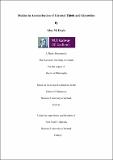Studies in anomerisation of glycosyl thiols and glycosides

View/
Date
2018-06-29Author
Doyle, Lisa M.
Metadata
Show full item recordUsage
This item's downloads: 77 (view details)
Abstract
The stereoselective generation of 1,2-cis linkages continues to be a substantial challenge in
carbohydrate chemistry today. Lewis acid-promoted anomerisation of 1,2-trans linkages offers
a facile method to generate 1,2-cis linkages. The primary aim of this thesis was on the
development of the anomerisation reaction, focusing on approaches that would improve the
rate of reaction and increase selectivity for the desired anomer. The first chapter outlines the
importance of carbohydrate chemistry and advances that have been made in anomerisation.
The second chapter of this thesis describes the anomerisation of a series of D-xylopyranosides,
L-arabinopyranosides and L-fucopyranosides. Elements that led to higher rates of epimerisation
were established by a kinetic study using 1H NMR spectroscopy to monitor the anomerisation
of the various glycosides under SnCl4-conditions. Crossover experiments were used to confirm
that xylopyranosides underwent epimerisation primarily through exocyclic cleavage, as
opposed to endocyclic cleavage.
The third and fourth chapters of this thesis detail the stereoselective epimerisation of glycosyl
thiols. Glycosyl thiols are widely used in stereoselective synthesis of S-glycosides due to their
configurational stability. Few methods exist for the stereoselective synthesis of 1,2-cis glycosyl
thiols. Their epimerization from 1,2-trans to 1,2-cis thiols was attained using TiCl4, while
SnCl4 promoted their axial-to-equatorial epimerization. The formation of a SnCl4-glycosyl
thiol complex accounted for the unusual equatorial selectivity obtained. The generation of a 2-
phenyl-1,3-oxathiolan-2-ylium cation is thought to somewhat explain the selectivity obtained
under TiCl4 conditions.
The final chapter outlines the efforts undertook in developing a synthetic route towards a
constrained sialylated galactose compound, which has potential as a hemagglutinin inhibitor
for influenza. The outbreak of a lethal strain of influenza remains a continual threat and the
development of novel inhibitors is vital, as there is widespread resistance in the influenza virus
against neuraminidase and M2 ion channel inhibitors. Research focusing on the development
of hemagglutinin binding agents is currently limited. This chapter summarises the development
of a synthetic pathway towards a novel hemagglutinin inhibitor based on work carried out
previously by the Murphy group.

